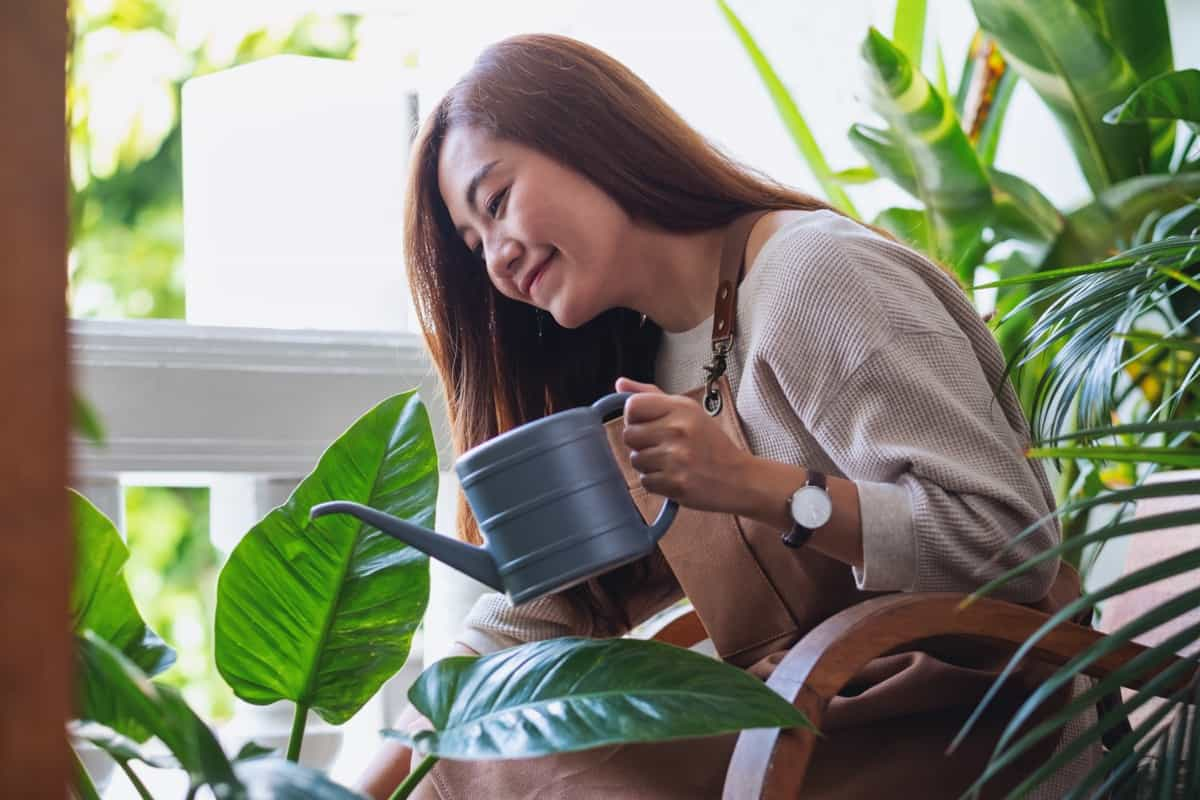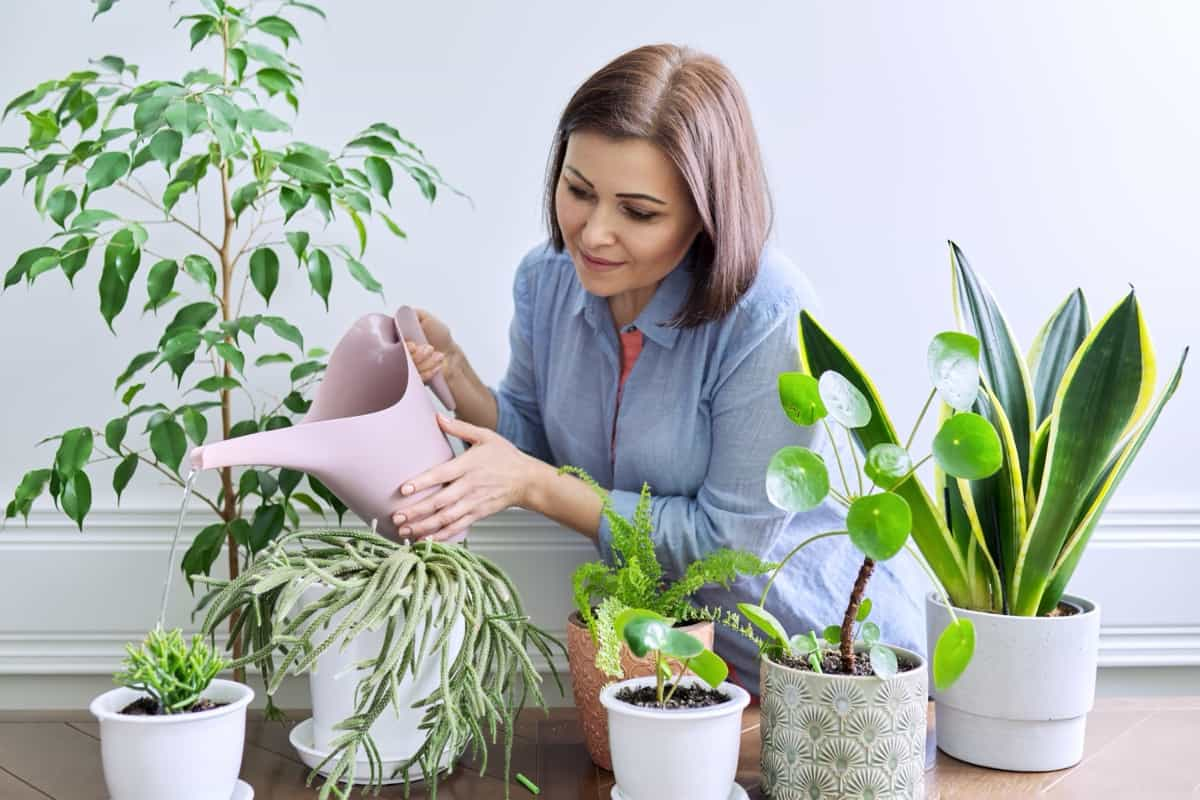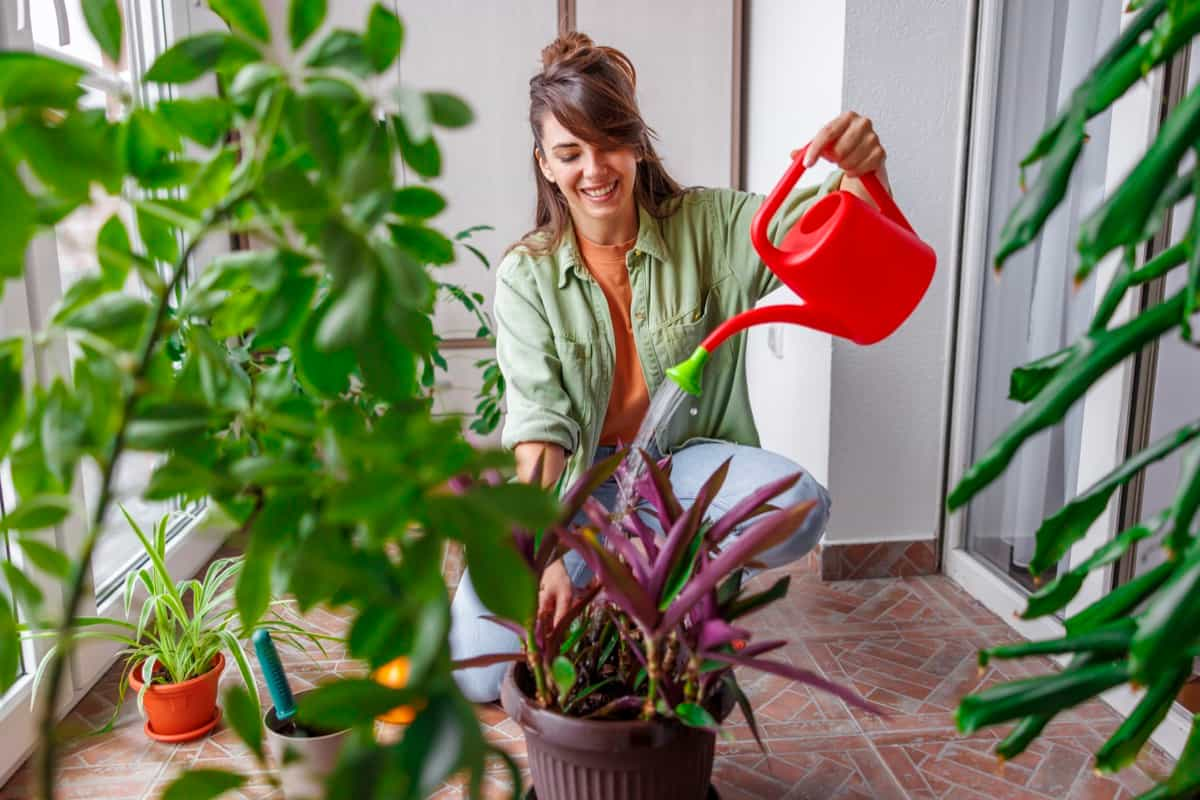Understanding the water needs of different plants is crucial for their overall health and well-being. Some plants, like succulents, prefer drier soil and can tolerate periods of drought. On the other hand, tropical plants thrive in more humid conditions and require regular watering. To determine the specific water needs of houseplants, consider factors such as the type of plant, its natural habitat, and its growth stage. Plants that are actively growing may need more frequent watering than those that are dormant or resting.

In addition to considering individual plant needs, you should also consider environmental factors like temperature and humidity levels in your home. Dry air can cause moisture to evaporate quickly from the soil, leading to dehydration in some plants. Another important aspect is understanding how much water each plant requires during different seasons. As temperatures rise during summer, many plants will need increased water due to higher evaporation rates.
Essential Tips on Watering Your Houseplants
Choose the Right Watering Can or Tool
Choosing the proper watering can or tool is essential for effectively and efficiently watering your houseplants. The type of tool you use can greatly impact how much water reaches the plants’ roots and how evenly it is distributed. One popular option is a long-spouted watering can, which allows for precise pouring directly at the base of the plant without splashing water on the foliage.
Another option is a spray bottle, ideal for smaller plants or those with delicate foliage that shouldn’t get wet. Spray bottles allow you to gently mist the plants with fine water droplets, mimicking their natural environment in humid regions.
Check the Moisture Level in the Soil
Checking the moisture level in the soil is a crucial step in watering your houseplants effectively. To ensure that you are providing just the right amount of water, it’s essential to assess the moisture content of the soil regularly. Start by inserting your finger about an inch or two into the soil. If it feels dry at this depth, it’s time to water your plant.
In case you missed it: Homemade Insecticide for Houseplants: Homemade Remedies for Natural Pest Control on Houseplants

However, if the soil feels damp or moist, hold off on watering for a few more days. Another way to check moisture levels is by using a moisture meter. These handy tools provide accurate readings and take out any guesswork. Simply insert the probe into the soil and read the results displayed on the meter.
Use Room Temperature Water
When watering houseplants, the water temperature you use is an essential factor to consider. Using room-temperature water can help ensure your plants receive optimal hydration without shock or stress. Using cold water straight from the tap can be jarring for your plants, especially if they are used to warmer indoor conditions. Similarly, hot or boiling water can scorch and damage their delicate roots. Room temperature water, on the other hand, is gentle and soothing for your plant’s root system.
Avoid Overwatering
Houseplant owners make one of the most common mistakes is overwatering their plants. Understanding the specific water needs of each plant in your collection is crucial. Some plants prefer drier soil, while others thrive in consistently moist conditions. Research the requirements of your plants and adjust your watering routine accordingly. Choosing the right potting mix is also essential in preventing overwatering. Opt for well-draining soil mixes that allow excess water to flow out easily. This helps prevent water from sitting around the roots and causing damage.
Provide Adequate Drainage
Providing adequate drainage is a crucial aspect of watering your houseplants that often gets overlooked. Proper drainage prevents water from accumulating in the soil and causing root rot or other moisture-related issues. Choosing pots or containers with drainage holes at the bottom is important to ensure proper drainage.
If your plant doesn’t have a drainage hole, consider using a layer of rocks or pebbles at the bottom of the pot to create some space for water to collect before reaching the roots. Another way to improve drainage is by using a well-draining potting mix. Look for mixes formulated explicitly for houseplants that contain ingredients like perlite or vermiculite, which help increase airflow and prevent compaction.
Adjust Watering Frequency Based on Season
Understanding the changing needs of your houseplants throughout the seasons is crucial for their overall health and well-being. As the weather changes, so do their watering requirements. In warmer months, plants tend to dry out more quickly due to increased evaporation, while in cooler months, they require less water as growth slows down. How often should you water indoor plants in summer?
In case you missed it: Natural and Organic Ways to Treat Houseplants Leaf Curl: Fix with Effective Home Remedies

Increasing watering frequency is important when temperatures rise and daylight hours lengthen during spring and summer. Keep an eye on the moisture level in the soil and adjust accordingly. This will ensure your plants receive enough hydration during these active growing periods. On the other hand, as fall transitions into winter, most indoor plants enter a state of dormancy or reduced activity. With lower light levels and cooler temperatures, they require less water.
Consider the Plant’s Growth Stage
Understanding the growth stage of your houseplants is crucial when it comes to watering them effectively. During the initial stages, such as seed germination or propagation, keeping the soil consistently moist but not saturated is essential. As your plants enter their active growth phase, they require more frequent watering.
This is because they actively use nutrients and water to fuel their growth. Monitor moisture levels in the soil regularly during this stage and adjust your watering accordingly. Once your plants reach maturity, their water requirements may change again. Some mature plants may need less frequent watering compared to younger ones. It’s essential to closely observe each plant individually and respond accordingly.
Use a Watering Schedule
Watering your houseplants regularly can help maintain their health and ensure they receive the right amount of moisture. Creating a watering schedule is especially important if you have multiple plants with varying water needs. To start, determine how often each plant should be watered based on its specific requirements.
Some plants prefer to dry out slightly between waterings, while others need moist soil. Take note of these preferences and create a schedule accordingly. Consider the pot size, humidity levels, and the season when establishing your watering routine. During warmer months or if you have particularly dry air indoors, you may need to adjust the frequency to prevent underwatering.
Water at the Base of the Plant
One important tip to remember when watering your houseplants is to water at the base of the plant. This means avoiding wetting the foliage unnecessarily and focusing on delivering water directly to the root system. Watering at the base allows the roots to absorb moisture more efficiently. Piquing water onto the leaves can lead to evaporation and may increase the risk of fungal diseases. By targeting the soil instead, you ensure that all that precious hydration goes where it’s needed most.
Use a Humidity Tray for Moisture-Loving Plants
One of the challenges of growing moisture-loving plants indoors is maintaining the right humidity level. These plants thrive in environments with higher moisture levels, so providing them with the necessary conditions is essential. One effective way to do this is by using a humidity tray. A humidity tray is a simple yet effective tool that can help increase the moisture in the air around your plants.
In case you missed it: Top 12 Winter Care Tips for Houseplants: Every Gardner Must Know

Choose a shallow dish or saucer slightly larger than your plant’s pot to create a humidity tray. Fill it with water halfway up the sides of the dish. Place your potted plant on the tray, ensuring its roots don’t encounter standing water. Evaporation will naturally increase humidity levels near your plants, creating an environment more suited to their needs. This can be especially beneficial during dry winters when indoor air is drier.
Monitor for Signs of Underwatering
To ensure you’re providing adequate hydration to your plants, keep a close eye on their foliage and soil. One telltale sign of underwatering is drooping or wilting leaves. When plants don’t receive enough water, they try to conserve moisture by closing their stomata (tiny leaf pores). This causes the leaves to lose turgidity and appear limp or wilted.
Another indicator is dry soil. Stick your finger about an inch into the potting mix – if it feels dry, it’s time to water. Additionally, some plants may start shedding leaves or develop brown edges when deprived of sufficient hydration.
Understand the Impact of Pot Size on Watering Needs
When watering your houseplants, understanding the impact of pot size is crucial. The size of the pot directly affects how much water your plant needs and how often you should water it. Plants in smaller pots dry out faster because there is less soil to hold moisture. This means they may require more frequent watering than larger pot plants. On the other hand, plants in larger pots have more soil volume, which can retain moisture for longer periods.
Use Self-Watering Pots for Convenience
Self-watering pots are a game-changer when it comes to watering your houseplants. These innovative containers have a reservoir at the bottom that holds water, allowing the plants to take up moisture as needed. This eliminates the guesswork and constant monitoring of soil moisture levels. One of the biggest advantages of self-watering pots is their convenience. You no longer have to worry about forgetting to water your plants or overwatering them.
In case you missed it: 7 Houseplants That Love Bottom Watering: A Beginners Guide

The reservoir provides a steady moisture supply, giving your plants the right amount they need. Another benefit of self-watering pots is that they help prevent root rot. Traditional pots with drainage holes can sometimes lead to excess water pooling at the bottom, which can suffocate roots and promote fungal growth. With self-watering pots, any excess water drains into the reservoir, keeping roots healthy and preventing waterlogged soil.
Adjusting Watering Based on Indoor Climate
Your home’s indoor climate can significantly impact your houseplants’ watering needs. Factors such as temperature, humidity levels, and air circulation all play a role in determining how frequently you should water your houseplants. Plants lose moisture more quickly when temperatures rise in warmer climates or during the summer months. You may need to water them more often to prevent dehydration. On the other hand, in cooler climates or during the winter, the air becomes drier and can cause moisture to evaporate more slowly.
In this case, you may need to reduce watering frequency. Humidity levels also affect plant hydration. Increasing watering frequency is important if your home has low humidity due to dry heat or constant air conditioning, as plants require more moisture. Conversely, if you live in a naturally humid environment or use humidifiers at home, you might be able to decrease watering slightly.
Use Rainwater or Distilled Water for Sensitive Plants
When watering your houseplants, not all water is created equal. Rainwater is naturally free from tap water’s chemicals, such as chlorine and fluoride. By collecting rainwater and using it to hydrate your sensitive plants, you’re providing them with a purer source of hydration that mimics their natural habitat.
Distilled water goes through a process where impurities are removed, resulting in pure H2O without any minerals or additives. This lack of minerals makes distilled water an excellent choice for sensitive plants since they may be more susceptible to mineral buildup from regular tap water.
Avoid Wetting the Foliage Unnecessarily
One common mistake many plant owners make is unnecessarily wetting the foliage of their houseplants. While giving your plants a spritz with a water bottle or misting them regularly may seem harmless, this can do more harm than good. When water sits on the leaves for an extended period of time, it creates a moist environment that encourages bacteria and fungi. This can lead to diseases such as leaf spot or powdery mildew, which can cause damage to your precious plants.
In case you missed it: List of Houseplants That Grow from Leaf Cuttings

Allow Tap Water to Sit Before Use to Dissipate Chemicals
When it comes to watering your houseplants, using tap water may seem like the most convenient option. However, it’s essential to be aware of the potential chemicals that can be present in tap water. Chlorine and fluoride are commonly found in tap water, and while they may not necessarily harm your plants, allowing the water to sit before using it can help dissipate these chemicals.
Letting tap water sit for at least 24 hours gives chlorine enough time to evaporate. This is especially beneficial for sensitive plants that may react negatively to chlorine or fluoride. Additionally, letting the water sit allows any heavy metals or other contaminants in the tap water to settle at the bottom of the container. Use a separate container designated for storing tap water to ensure optimal health for your houseplants. This way, you won’t accidentally mix untreated tap water with fresh supplies for watering your plants.
Conclusion
Watering your houseplants correctly is essential for their health and vitality. Remember that each plant is unique in its requirements. It’s crucial to pay attention to individual needs and adjust your watering practices accordingly. You can create a thriving indoor garden filled with lush greenery by developing good habits when watering your houseplants.
- Where to Place Indoor Plants in Your Home
- How to Grow Tomatoes Organically at Home: A Comprehensive Guide
- Organic Gardening on a Budget: Low-Cost Methods and Materials
- Gongura Seed Germination and Planting Methods
- Cabbage Seed Germination and Selection
- Broccoli Seed Germination and Selection
- Asparagus Seed Germination and Variety Selection
- Seasonal Flower Gardening: Best Practices for Spring, Summer, Fall, and Winter
- How to Grow Hibiscus from Flower
- Plantation Ideas for Home Decoration: A Beginners Guide
- Flower Garden Designs and Layouts for Beginners
- Planting and Spacing Techniques in Papaya: A Beginner’s Guide
- Growing Gold: Essential Techniques for Planting Pineapples
- How to Make Kalanchoe Plant Bushy: Home Remedies and Solutions
- 11 Reasons Why Your Gardenia is Not Blooming: Home Remedies and Solutions
- Eco Elegance: The Guide to Designing a Drought-Tolerant Landscape
- Gardening on a Slope: Strategies for Hillside Landscaping
- Nourish and Flourish: Top Organic Mulches for Thriving House Plants
- Everything You Want to Know about Indian Mogra Flower: Discover Uses and Growing
- Green Thumb Success: Expert Tips for Cultivating Greenhouse Pumpkins All Year Round
- Maximize Growth & Flavor: The Ultimate Guide to Companion Planting in Herb Gardens
- How to Control Rhododendron Problems Naturally: Home Remedies and Organic Ways to Fix Them
- Natural Magic: The Remarkable Benefits of Cinnamon for Plants
- Best Steps to Revive Dying Tulip with Natural and Organic Treatment
- 10 Reasons Why Your Angel Trumpet is Not Blooming: Remedies and Treatment
- How to Fix Periwinkle Leaf and Flower-Related Problems: Natural Remedies and Solutions
- How to Fix Zinnias Leaf and Flower Problems: Discover Natural and Home Remedies
- Organic Steps to Induce Lemon Tree Flowers: A Comprehensive Guide
- Bloom Booster: Crafting the Perfect Homemade Bougainvillea Fertilizer
- Optimizing Growth: A Guide to Applying NPK Fertilizer for Potted Plants
- 10 Best Homemade Fertilizers for Rubber Plant: DIY Recipes and Application Method
- How to Boost Female Pumpkin Flowers: Effective Steps for More Flowers and High Yields
- Transform Your Indoor Garden: Top Benefits of Pink Salt for Houseplants
- 10 Best Homemade Fertilizers for Peacock Plants (Calathea): Easy DIY Guide
- Unlock Blooms: 9 Reasons Why Your Potted Chrysanthemum is Not Blooming
- 8 Reasons Why Your Potted Hibiscus is Not Blooming: Fix it with Simple Solutions